Kiteboarding Insights and Tips from KiteFusions
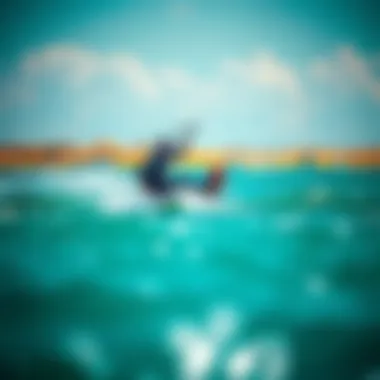
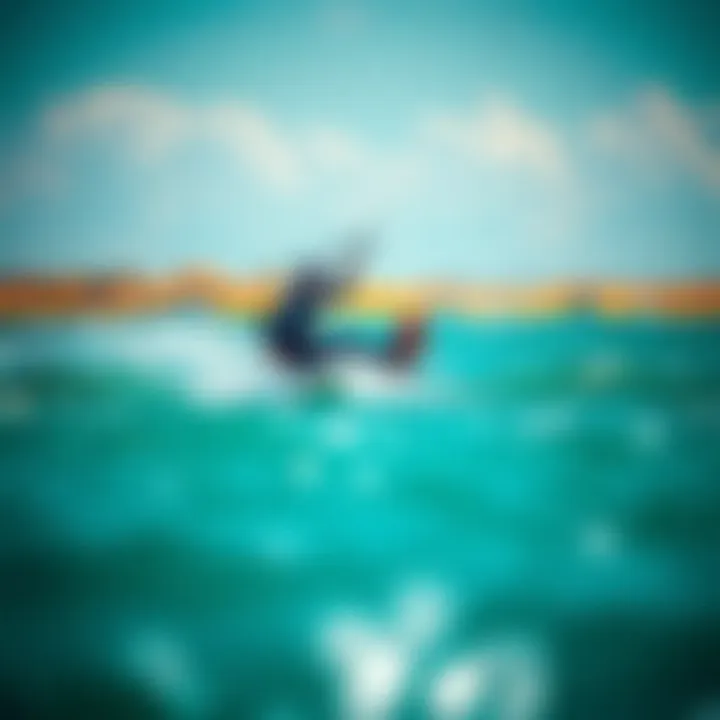
Intro
Kiteboarding has been making waves in the outdoor sports arena, captivating folks from all walks of life. It’s a medley of thrill and tranquility—a chance to dance with the wind while gliding across expansive water. In this exploration, we journey through the exciting world of kiteboarding, as curated by KiteFusions, a name synonymous with passion and expertise in this exhilarating sport.
Understanding the intricacies of kiteboarding is crucial for both newcomers and seasoned veterans. Whether you’re just starting or you’re looking to refine your skills, this guide will unfold a treasure trove of insights. From essential gear that can make or break your ride to safety tips that keep you secure while you’re out chasing the wind, we cover it all. Follow along as we dive into the finer details and uncover top spots that kiteboarders should consider for their next adventure.
Now, let’s take a closer look at the gear and equipment that forms the backbone of every kiteboarder’s experience.
Gear and Equipment
Essential Kiteboarding Gear for Beginners
When dipping your toes into kiteboarding, the right gear is imperative. The learning curve can be steep, but having suitable equipment can ease the journey. Here are the must-haves:
- Kite: The heart of your setup, kites are available in various sizes and designs. Beginners often start with a medium-sized inflatable kite which offers a good balance of power and control.
- Control Bar: This is your connection to the kite, allowing you to steer and manage power. Look for a bar that feels comfortable in your hands and has easy-to-use features.
- Harness: A well-fitted harness distributes the load from the kite, saving your arms from fatigue. Choose between waist and seat harnesses based on personal comfort.
- Board: The right board—one that provides stability and control—is crucial for learning. Many beginners prefer wider boards as they offer better stability and are more forgiving.
- Safety Leash: This is a must-have to ensure that if you let go of the bar, the kite is safely controlled. Don’t skimp on safety accessories.
Advanced Equipment for Experienced Riders
For those who have mastered the basics and seek to elevate their performance, investing in advanced equipment is key. Here’s what seasoned kiteboarders often choose:
- High-Performance Kites: These kites are designed for various weather conditions. Riders might choose specific kites for freestyle or wave riding, tailored to their unique style.
- Specialized Boards: Advanced riders often opt for slimmer boards or directional boards for different styles, such as racing or freestyle tricks.
- Bar with Adjustable Lines: Allows for quick adjustments based on changing wind conditions without having to swap gear mid-session.
- Foot Straps or Bindings: Choosing between them can influence your technique. Bindings provide a locked-in feel, ideal for aggressive maneuvers, while straps offer more freedom and ease of learning.
Now that we have laid out the gear essentials, let’s delve deeper into the techniques and tips that can help riders, both novice and expert, enhance their performance on the water.
Techniques and Tips
Basic Riding Techniques for Newbies
Learning kiteboarding is like learning how to ride a bike—you’ll have your fair share of tumbles, but persistence pays off. Here are key techniques to focus on:
- Wind Understanding: Learn how to read wind conditions, which is crucial for safe and enjoyable riding.
- Body Positioning: Keep your weight centered on the board and knees slightly bent for better balance.
- Kite Control: Practice moving the kite in the wind window to get a feel for its pull.
Expert Tricks to Elevate Your Skills
For those looking to spice things up, mastering these tricks can take your kiteboarding game to the next level:
- Jumping: Start with small jumps by using the kite’s power to pop off the water.
- Board Off Tricks: Once comfortable, try detaching your board mid-air and creatively re-attaching it on landing.
- Handle Passes: This involves passing the control bar to the other hand while airborne, a skill that shows control and style.
Mastering these techniques can be more satisfying than a cold drink after a scorching session. The possibilities with kiteboarding are endless, turning every outing into a new adventure.
To further enrich your kiteboarding experience, consider joining communities and forums, like those on reddit.com, where enthusiasts share tips and organize meet-ups. Whether you’re seeking advice, local spots, or just a friendly chat about gear, the kiteboarding community is a welcoming place.
Prolusion to Kiteboarding
Kiteboarding represents the thrilling intersection of creativity, technical skill, and an undeniable connection to nature. This sport allows individuals to harness the wind, gliding over water with grace and speed. In this article, we will peel back the layers of kiteboarding, offering insights that appeal to both newcomers eager to ride and seasoned veterans looking to refine their expertise.
Moreover, understanding kiteboarding is pivotal for several reasons. It’s not merely a pastime; it's a lifestyle built on adventure, community, and a healthy appreciation for the great outdoors. For kiteboarders, the experience translates into exhilarating moments that can change from serene enjoyment to adrenaline-packed excitement within seconds. This duality fascinates many, drawing them toward this sport.
A Brief History of Kiteboarding
Kiteboarding’s roots date back several centuries. The earliest recorded use of kites for propulsion can be traced back to ancient China and then later to Europe, where kites were employed for various purposes including military reconnaissance and meteorological observations.
However, the modern form of kiteboarding as we know it began to take shape in the late 20th century. In the 1980s, innovators started experimenting with water kites and tow-in surfing, merging elements of surfing, windsurfing, and paragliding. There were a few individuals and communities, notably in Hawaii and France, who really pushed the envelope, laying the groundwork for today’s dynamic sport.
By the late 1990s, the technology behind kites advanced significantly, addressing safety issues and ease of use. The introduction of inflatable kites represented a breakthrough, allowing more riders to enter the fray. As the sport gained traction globally, kiteboarding schools and competitions started sprouting up everywhere—from sandy beaches in the Caribbean to windy coastline in Europe.
Overall, the evolution of kiteboarding is a testament to human creativity and resilience. It’s fascinating that what began as a quirky idea amongst a few avid surfers has morphed into a global phenomenon.
Understanding the Basics
At its core, kiteboarding combines two key elements: flying a kite and riding a board. One might think of the kite as the engine and the rider as the machine, working in unison to harness the power of the wind.
First things first, it’s essential to grasp the basic components of this sport. Here’s a breakdown:
- Kite: The heart of the sport. Kites come in various shapes and sizes, each designed for different wind conditions and riding styles. A larger kite catches more wind, increasing power but may be harder to control, while a smaller kite is more agile.
- Board: Generally similar to a wakeboard or snowboard, the board provides the surface for the rider to glide on. Some boards are designed for freestyle maneuvers, while others focus on speed or stability.
- Harness: This piece of gear connects the rider to the kite, distributing the pull across the body, allowing for better control and reduced fatigue.
A typical session begins by assessing the wind conditions—this is where the experience of a rider truly shines. Understanding gusts, lulls, and the local weather patterns can differentiate a strong session from a challenging one.
The movements in kiteboarding revolve around body control: shifting your weight, maneuvering the kite, and maintaining balance on the board. It requires practice and precision, making classroom-style learning beneficial.
In essence, mastering the basics sets the stage for a rewarding journey ahead. As each kiteboarder develops their style, they build upon foundational skills that elevate their experience, both personally and communally.
Essential Gear for Kiteboarding
Kiteboarding is not just about riding the wind; it’s also about having the right gear to make your experience safe and enjoyable. Whether you’re just starting or you’re well on your way to being an expert, understanding the essential equipment can dramatically impact your performance and safety. Each component plays a vital role, and knowing what to choose can make all the difference.
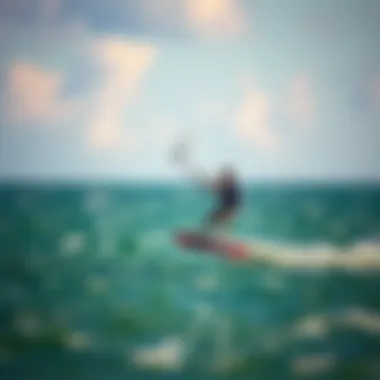
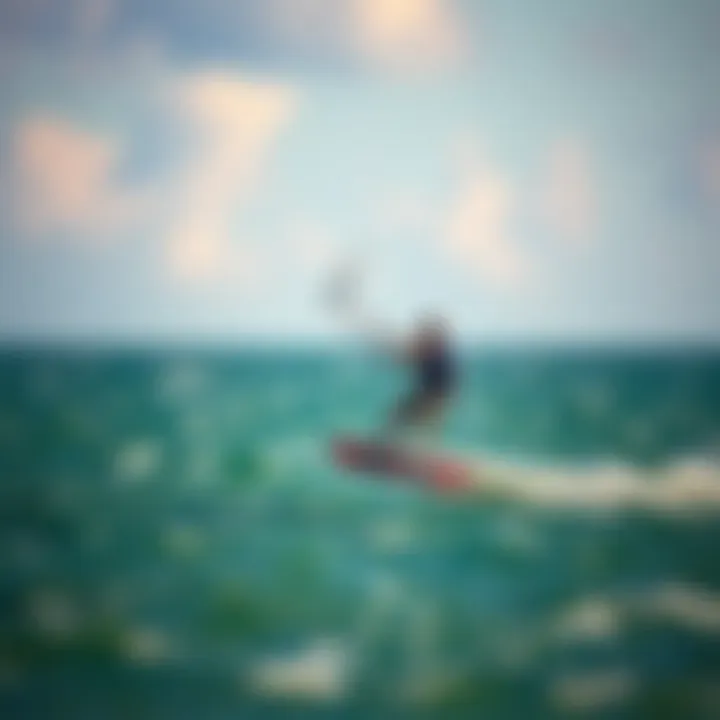
First, think of kiteboarding gear as a cohesive unit. You have the kite, the board, and the harness, each designed to work together for maximum efficiency. Choosing these pieces wisely can enhance your experience on the water, allowing for smooth navigation and impressive tricks. Plus, a well-selected set of gear will offer comfort and stability, crucial for those extended rides where you lose track of time.
When it comes to kiteboarding, the importance of suitable gear is two-fold: enhancing your performance and prioritizing safety. A mismatched setup can hinder your ability to maneuver, which could lead to accidents or even injuries. Thus, it’s paramount that you connect with knowledgeable retailers or experienced kiteboarders who can guide you in making well-informed decisions.
Choosing the Right Kite
Selecting the appropriate kite is perhaps the most critical choice in gear acquisition. The kite you choose impacts everything from your speed to your ability to perform stunts. Kites come in various shapes, sizes, and materials, each tailored for different conditions and skill levels.
- Types of Kites: Generally, you'll find three types of kites available: foil kites, delta kites, and leading-edge inflatable kites.
- Foil Kites: Great for beginners due to their simplicity and lightweight design. They respond well to light winds.
- Delta Kites: Known for their high stability and excellent lift, useful for both novice and advanced riders.
- Leading-Edge Inflatable Kites: Ideal for those who are more experienced. They offer superior performance in various wind conditions.
Moreover, pay attention to the size of the kite. A larger kite catches more wind, letting you ride in lighter conditions, whereas a smaller one is better for stronger winds and more advanced tricks. Don’t forget to take your weight and skill level into account.
Harnesses and Control Bars Explained
Next up is the harness, an often underrated yet pivotal piece of equipment in kiteboarding. A good harness not only keeps you connected to the kite but also distributes the pull across your body, easing the strain on your arms and shoulders.
- Types of Harnesses:
- Waist Harness: Most common choice, offering a low-profile fit and better mobility. Ideal for doing high jumps and more aggressive movements.
- Seat Harness: Provides extra support and is recommended for beginner kiteboarders. It sits lower on the body and helps maintain a stable position during rides.
Complementing the harness is the control bar, a critical interface in managing your kite. The control bar allows you to steer and adjust the kite’s power. Look for features like adjustable widths which can improve comfort and control during your rides. Remember, comfort in your harness and precision in your control bar drives your performance, so don’t skimp on quality.
Board Varieties and Their Technologies
Lastly, let’s talk board varieties. Your kiteboard is your ticket to carving up the water, and understanding the different types can help you pick the right one for your style.
There are primarily two styles of boards: twin-tip boards and directionals.
- Twin-Tip Boards: Versatile and user-friendly, they allow you to ride in both directions without needing to change your stance. Great for both beginners and experts looking to perform tricks.
- Directional Boards: Best suited for experienced riders. These boards require you to ride in one direction, offering more control in high speeds and waves.
In addition, consider the technology involved in board construction: materials like carbon fiber and lighter woods can contribute to a board's overall performance and responsiveness.
"Kiteboarding isn’t just a sport; it’s a lifestyle that demands both skill and the right gear to unlock its full potential."
In summary, the right gear significantly enriches the kiteboarding experience. By understanding kites, harnesses, and boards and selecting the right options for your needs; you'll be better equipped not only to enjoy the thrill of kiteboarding but to master it with safety and finesse.
Techniques and Tips for Beginners
When beginning your journey into kiteboarding, it can feel like standing at the edge of a vast ocean of information. Proper techniques and tips act as your lifeline, guiding you away from pitfalls and steering you toward enjoyable, successful rides. Understanding the fundamentals is not just beneficial; it's crucial for safety and for instilling confidence in new kiteboarders. You wouldn't want your initial attempts to end in disaster—you'll want to glide gracefully atop the waves, right?
Getting Started: First Steps
First and foremost, finding an instructor is paramount. Attempting to learn kiteboarding on your own can lead to frustration or, worse yet, injury. A professional will walk you through essential safety protocols, help you understand wind patterns, and teach you how to control the kite. You’ll learn the difference between the pull of the kite versus the dynamics of your board, which is significant for maintaining balance and composure.
Before even stepping onto the water, practice with your equipment on land. This includes the proper way to set up your kite and how to launch it effectively. The most efficient way is to find a buddy to assist you? It's always safer and will give you more confidence. Here are a few key points to keep in mind:
- Kite Control: Familiarize yourself with the kite's movements by practicing figure eights in the sky. This exercise can help you understand how to direct your kite efficiently.
- Safety Zones: Always be aware of your surroundings. Know your launch and landing areas. Having a clear understanding could prevent accidents where others are sharing the beach or water.
- Body Positioning: Keep your body low and maintain a wider stance while kiteboarding; this can improve stability and help you achieve better control.
Fundamental Maneuvers to Master
Once you're comfortable with the kite and can launch and land effectively, it’s time to hone in on fundamental maneuvers. These basics will set the groundwork for your future as a kiteboarder. Here’s where it gets exciting!
- Water Start: This is arguably one of the most important skills to master. With your kite properly positioned, you’ll learn to pull yourself up from the water by engaging your core and using the kite's power.
- Edge Control: Practicing how to edge the board when powered up is crucial. This technique will enable you to ride with more control and confidence, steering away from choppy waters or obstacles.
- Transitions: Learning to switch your stance while in motion helps in maneuvering the board more efficiently. The fluidity of transitions adds style to your performance and makes for seamless riding.
- Jumps: Though it sounds advanced, starting with small jumps can add versatility to your riding. Work on your timing with the kite to boost yourself off the water. A little bit of practice goes a long way!
"Start slow; progress will come. Every kiteboarder was once a beginner."
By staying committed to mastering these techniques, you’ll find kiteboarding moving from a challenging pursuit to an exhilarating experience. Develop your skills, listen to seasoned kiteboarders, and remember that every ride offers a lesson. Whether you’re off to gallivant across the waves or simply looking to enjoy the tranquility of gliding over the water, the initial techniques you cultivate will be the bedrock of your kiteboarding journey.
Advanced Techniques for Experienced Riders
As kiteboarding evolves, riders find themselves continually seeking new ways to elevate their skills and enhance their experience on the water. This section takes a closer look at advanced techniques designed for those who have mastered the basics and are eager to explore more exhilarating aspects of the sport. Not only do these techniques provide an opportunity for personal growth, but they also deepen one’s connection to the kiteboarding community. Achieving mastery in these areas can be rewarding, and it can foster a sense of accomplishment that resonates well beyond the water.
Exploring Advanced Maneuvers
When it comes to advanced maneuvers, kiteboarders can break away from routine while pushing their limits. Mastering tricks like the backroll, front roll, or even unhooked jumps requires not just skill but a solid understanding of the mechanics of movements. These maneuvers demand sharp reflexes, proper stance, and precise timing.
- Backroll: This trick involves rotating the board and body backward while airborne. It's an excellent entry into more complex aerial moves.
- Kite Loop: A definitive crowd-pleaser, this technique entails spinning the kite in a loop while jumping, which leads to explosive height and dynamic rotations.
- Unhooked Tricks: Getting unhooked from the harness adds an extra layer of difficulty and opens up a whole new realm of tricks; however, it requires a strong grasp of kite control.
The practice of these maneuvers must be approached with caution. Riders should consider starting with less aggressive moves, gradually easing into more complex tricks as confidence grows. Additionally, practicing in safe environments—away from obstacles and with favorable wind conditions—can minimize risks while maximizing learning potential.
"Mastering advanced maneuvers in kiteboarding not only elevates your skill set but also allows you to connect with a broader community of passionate riders."
Tricks and Improvements for Performance
Improving performance goes hand in hand with learning tricks. Effective riders often focus on a blend of refinement and innovation in their techniques. Here are some key areas of improvement:
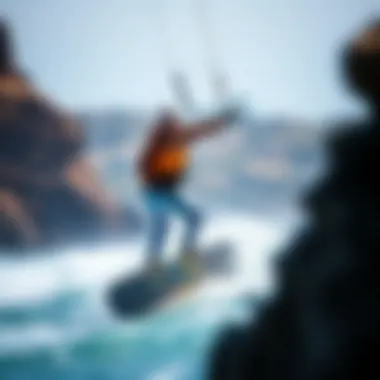
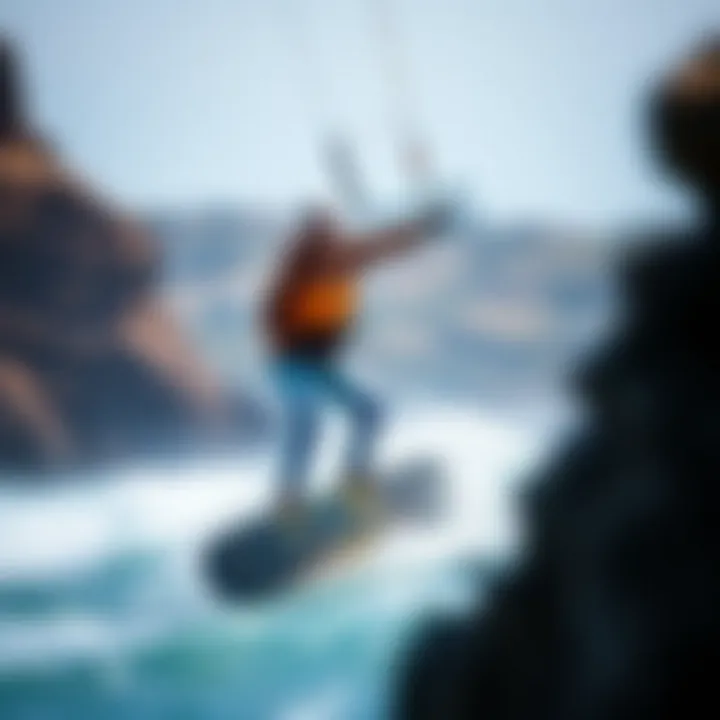
- Timing and Coordination: Understanding when to pull the kite, how to balance weight distribution, and synchronizing movements can significantly affect the quality of jumps and maneuvers.
- Conditioning and Strength: Maintaining physical fitness is crucial. Engaging in strength training, flexibility exercises, and cardiovascular workouts can enhance endurance and reduce the likelihood of injury.
- Video Feedback: Analyzing footage of your riding can reveal areas for improvement that may not be evident in real-time. It’s a crucial tool for informed progression.
Practicing tricks within a supportive community also fosters an environment for sharing techniques. Local groups often host sessions where riders can learn from one another, gain insights, and push each other to experiment with new approaches. Beyond personal development, these practices can encourage a healthier interaction with equipment—exploring how to manipulate kites and boards more effectively enhances not just individual rides but also contributes to the overall kiteboarding culture.
In summary, focusing on advanced techniques and performance improvements can unlock new dimensions to kiteboarding. The joy of riding should stem from the thrill of challenge and improvement, coupled with a community spirit that collectively elevates the performance of each rider.
Safety Considerations in Kiteboarding
Kiteboarding, while an exhilarating sport that connects you with nature like no other, does come with its share of risks. The broad spectrum of safety considerations is paramount not just for the experienced flyers, but also for newcomers who might still be getting their sea legs. Prioritizing safety can mean the difference between a memorable day on the water and a potentially hazardous situation.
It goes without saying, one of the most critical aspects of kiteboarding safety is the ability to read the weather conditions. A good understanding of the climate can help you determine when it's the best time to hit the waves—and when to stay ashore altogether.
Understanding Weather Conditions
Weather can change about as fast as a kite can catch a gust, so it’s vital for kiteboarders to remain vigilant. Here are a few key elements to watch out for:
- Wind Speed: Optimal wind speeds for kiteboarding typically range between 12 to 25 knots. Winds outside this range can pose serious challenges, leading to overpowered kites or insufficient lift.
- Gusts and Turbulence: Sudden wind gusts can catch even the most seasoned riders off guard. It's important to assess whether the wind is consistent or if it's likely to change abruptly.
- Storms: Thunderstorms can develop rapidly. Keep an eye on the horizon—dark clouds or shifting winds can signal that conditions are about to worsen.
- Tides and Currents: Knowing the tide schedules and anticipating currents is essential. An outgoing tide can significantly change the conditions you're riding on, carrying a boarder away from the launch area or creating unexpected hazards.
A smart rider is one who checks the weather forecasts and has a plan in case conditions change unexpectedly.
Essential Safety Gear
Gear is more than just functional; it can ultimately save lives. Kiteboarding requires specific safety equipment that goes beyond the kite and the board. Here’s a rundown of the essentials:
- Helmet: Protecting your head should always be the top priority. A well-fitting helmet can guard against bumps and falls.
- Impact Vest: This isn’t about looking cool; it’s about cushioning those inevitable bounces when you take a tumble. Impact vests provide flotation and help mitigate injury.
- Leash: The leash is your lifeline. It connects you to your kite and keeps it from drifting away in case of an emergency, allowing you to focus on getting back to safety.
- Safety Release Systems: Familiarize yourself with the best practices for your kite's safety release system. Understand how and when to use it; in a pinch, it can instantly detach you from a tangled kite.
- First Aid Kit: While we hope to never need it, having a basic first aid kit can make a significant difference in case of minor injuries.
"Preparation is the key to success in kiteboarding. Not just in skill, but in ensuring that every ride is as safe as it can possibly be."
By investing time in understanding the often-overlooked intricacies of safety in kiteboarding, you're allowing yourself the freedom to enjoy this sport to its fullest—and you just might inspire others to do the same. As you hit the water, keep these considerations in mind, and you'll find that safety often leads to greater enjoyment.
Choosing the Right Kiteboarding Destination
Selecting the right kiteboarding destination can truly make or break your experience on the water. This decision encompasses various factors, from wind consistency to water conditions and local culture. Each location offers its unique flavor and opportunities, influencing not just your riding skill development but also your overall enjoyment. You wouldn't choose a dessert without knowing its taste, right? The same goes for picking your kiteboarding spot.
- Wind Conditions: The wind's reliability is paramount. Before you head out, it’s essential to research local wind patterns and averages throughout the year. This will save you from wasted time on calm days. Popular destinations often have predictable wind conditions during particular seasons.
- Water Type: Depending on your skill level, you might prefer flat water or waves. Beginners often benefit from flat water for practice, while seasoned riders may seek out those adrenaline-pumping waves. Balance between comfort and challenge plays a crucial role in your choice.
- Safety Considerations: Understanding local hazards like currents, tides, and potential obstacles is crucial for a satisfying experience. Look into local regulations concerning kiteboarding to ensure that you stay within the lines.
- Community and Culture: Engaging with the local kiteboarding community can enhance your experience. Consider if the destination has schools, shops, or local events which can help you connect with fellow enthusiasts.
- Accessibility and Amenities: Consider your overall travel experience. Check if the destination has adequate housing options, food availability, and transportation facilities—this can all impact your kiteboarding adventure.
"A great kiteboarding destination is more than just wind and water; it's about the community and culture you engage with."
Top Spots Around the World
When it comes to kiteboarding, certain places around the globe have earned their stripes as must-visit spots, revered for their exceptional conditions and vibrant scenes.
- Tarifa, Spain: Known as the wind capital of Europe, Tarifa boasts consistent winds and a stunning backdrop of beaches. The lively town is brimming with bars, shops, and a plethora of riders sharing their passion.
- Cape Town, South Africa: With breathtaking scenery and powerful winds, Cape Town draws in riders from all corners. The diverse landscapes offer everything from flat water lagoons to challenging waves at spots like Big Bay and Blouberg.
- Maui, Hawaii: Aside from its iconic beaches, Maui’s trade winds offer superb kiteboarding conditions. Couple that with the breathtaking surroundings, and you have a destination that feels like paradise.
- The Bahamas: With its crystal-clear waters and less crowded beaches, the Bahamas is often a top choice for those wanting a serene kiteboarding experience combined with gorgeous beach vibes.
Every spot has its own set of vibes, explaining the dynamic journey that kiteboarding can offer. Seek local advice, but don’t forget to enjoy the journey of discovery yourself.
Secret Hidden Gems for Enthusiasts
For those in the know, the true adventure often lies in lesser-known spots that harbor incredible potential for kiteboarding.
- Lofoten Islands, Norway: Here, you’ll find beautiful, rugged landscapes with consistent winds during summer months. It’s off the beaten path but worth every effort for its stunning sceneries and fewer crowds.
- Cumbuco, Brazil: Just north of Fortaleza, Cumbuco is a small fishing village that has gained momentum among kiteboarders. Its warm winds and inviting waters set the stage for a relaxed vibe.
- Dakhla, Morocco: Nestled between mountains and the sea, Dakhla offers a unique blend of flat water and small waves along with a community feel that’s hard to beat. It's often overlooked but is a treasure in the kiteboarding world.
- Hokkaido, Japan: Known for its snowy winters, Hokkaido transforms into a stunning summer kiteboarding destination. The unique landscapes and local culture provide an unmatched experience.
Exploring these secret spots may lead you to discover not only new challenges but also a deeper connection with the sport. The beauty is often in the adventure of finding these undiscovered jewels.
The Kiteboarding Community
The kiteboarding community serves as the backbone of this thrilling sport, binding enthusiasts through shared experiences, challenges, and triumphs. More than just a group of riders, it embodies a way of life, promoting values like camaraderie, respect for the environment, and a passion for adventure. The community is just like a tightly woven kite line; each connection adds strength and stability to the sport.
Joining this vibrant community gives riders access to a wealth of knowledge and support. From locals who know the ins and outs of their favorite spots to seasoned pros willing to share their tricks and tips, the opportunities for growth are abundant. Moreover, community involvement fosters a culture of safety and responsibility, which is especially critical for those who are still finding their footing on the water. Together, riders are more equipped to navigate the challenges, celebrate the successes, and promote the sport in a sustainable way.
"Kiteboarding is not just about the individual pursuit of wind and waves, but about the friendships and connections we forge along the way."
Connecting with Fellow Riders
Establishing connections with fellow kiteboarders is akin to catching the perfect wind: the more you invest in building relationships, the smoother your journey becomes. Local groups often organize meet-ups, where riders share tips and tricks, discuss gear choices, and maybe most importantly, enjoy each other's company. These gatherings can happen on sandbars, at popular beaches, or offshore islands where riders congregate.
Many social media platforms offer vibrant spaces for kiteboarding enthusiasts to engage, like Facebook groups and Reddit forums. These platforms allow members to post questions, share photos, and arrange kiteboarding trips together. The ease of digital communication has broken geographical barriers and allowed kiteboarders worldwide to share insights on local spots, gear recommendations, or even travel tips. For those venturing into unfamiliar waters, connecting with other riders can provide critical local knowledge that enhances the overall experience.
In addition to virtual interaction, in-person connections are vital, especially when it comes to participating in community-led initiatives like cleanups or local charity events. Sharing a mission to protect the ocean can be a bonding experience that fosters a deeper sense of responsibility.
Local Events and Competitions
Events and competitions are the beating heart of the kiteboarding community. They not only offer a platform to showcase talents but also serve as social gatherings where friendships blossom among competitors and spectators alike. Many riders find inspiration and motivation by watching others push the boundaries and achieve feats they once thought unthinkable. Events range from informal fun competitions to high-stakes professional contests, catering to riders of all levels.
Additionally, local shops and schools often host kiteboarding events that introduce novices to the sport while experienced riders fine-tune their skills. These gatherings also provide the community with opportunities to learn about safety measures and environmental practices, ensuring that kiteboarding remains enjoyable for everyone.
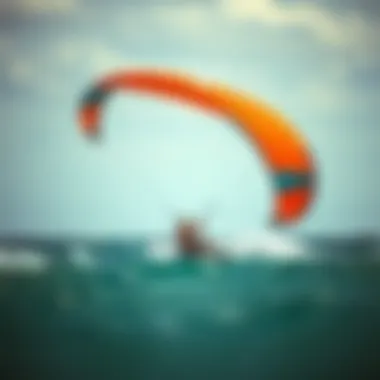
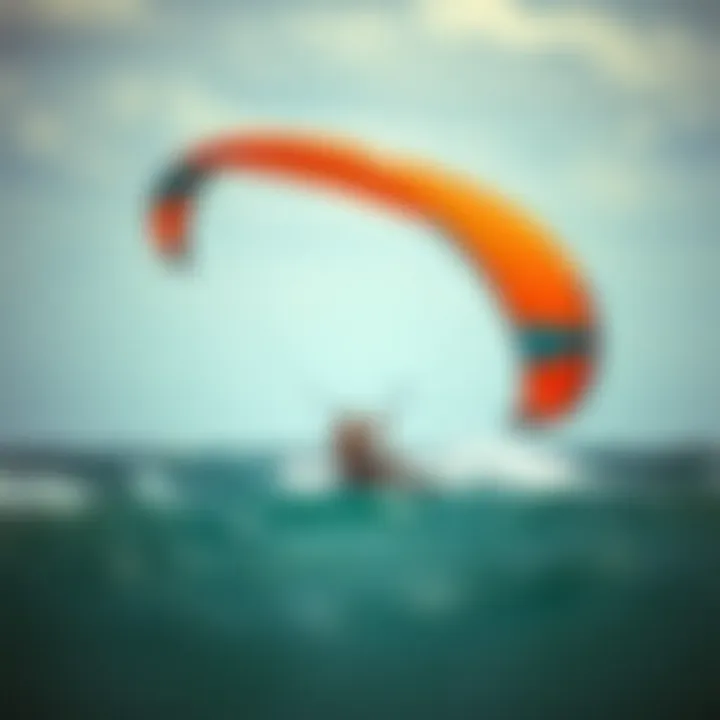
Competitions, like the World Kiteboarding League, draw large crowds and significant media attention, ultimately contributing to the growth of kiteboarding on a global scale. Attending these events can give riders a sense of belonging within the larger kiteboarding community while also providing insight into emerging techniques and tricks that may enhance their own riding.
In summary, the kiteboarding community represents more than just a shared interest in the sport; it is a network of connections that enhances the overall kiteboarding experience, from local events and competitions to the bonds formed between riders. The relationships nurtured within this community can make even the most challenging days on the water memorable, as kiteboarders support each other's journeys through the waves, wind, and beyond.
The Role of Technology in Kiteboarding
In recent years, technology has carved out a prominent space in the kiteboarding universe, making the sport not only more accessible but also safer and more enjoyable. Innovations in gear design, data-driven enhancements, and advancements in safety and performance have transformed kiteboarding into a highly technical sport. Riders, whether they are just dipping their toes into the water or zooming through waves like seasoned pros, can harness these technological improvements to elevate their experience.
Innovations in Kite Design
The evolution of kite design reflects the interplay between engineering and the demands of riders. Modern kites have become lighter, more durable, and easier to handle compared to their older counterparts. Key innovations include:
- Material Technology: Today’s kites are often made from ripstop nylon or polyester, featuring reinforced stitching. These materials help reduce weight while increasing durability. The result? Kites can withstand stronger winds and endure tougher conditions without compromising performance.
- Design Shapes: Variations such as C-kites, Delta kites, and Bow kites have different attributes catered to specific styles of riding and wind conditions. For instance, Bow kites are known for their stability and power efficiency, making them ideal for beginners.
- Adjustable Features: Many modern kites offer adjustable struts and inflation systems, allowing riders to customize their kites for varying wind conditions. This functionality can significantly enhance the rider’s control and overall experience on the water.
As technology continues to advance, we can expect even more tailored kite designs that cater to personal preferences and styles. The possibilities seem endless as manufacturers explore new shapes and materials.
Using Apps and Devices for Enhancement
The integration of apps and gadgets in kiteboarding has taken rider experience to a new level. With a smartphone in hand, enthusiasts can track their progress, learn new techniques, and connect with fellow riders around the globe. Here are some beneficial tools:
- Kiteboarding Apps: Applications like KiteLapse or Windy allow users to monitor wind conditions, track movements, and analyze performance statistics. This data can help users identify their strengths and areas for improvement.
- GPS Devices: These tools provide not just speed and distance metrics but also the opportunity to map out tricks and routes during a session. By reviewing performance data, riders can fine-tune their skills and set personal goals.
- Social Media Platforms: Connectivity is essential in the kiteboarding community. Platforms like Reddit and Facebook Groups serve as venues to share experiences, ask for advice, and even organize local meetups for kiteboarding sessions.
"The real magic of technology lies in its ability to create connections and shared experiences among riders, regardless of location."
For more information on kiteboarding technology, you can check out resources like Britannica or local forums on Reddit.
Environmental Impact and Sustainable Practices
The issue of environmental impact and sustainable practices holds significant weight in the world of kiteboarding. As more enthusiasts hit the water, it’s essential to examine how this exciting sport interacts with our environment. Understanding this topic is not only a matter of personal responsibility but also an avenue for enhancing our kiteboarding experiences while preserving the natural beauty of our chosen settings.
The environmental concerns surrounding kiteboarding include:
- Ecosystem Disruption: Each kiteboarding site often has delicate ecosystems. The roar of our pumps and the bluster of our kites can disrupt wildlife, particularly in nesting areas along coastlines.
- Pollution: From the materials used in kites and boards to the waste created during events and outings, pollution management needs attention to minimize our imprint on nature.
- Resource Consumption: The production of equipment often requires significant resources, contributing to a larger carbon footprint.
By acknowledging these issues, we can take concrete steps to lessen our impact while enjoying the thrill that comes with soaring above aqua vistas.
Understanding Environmental Concerns
When we dive deeper into environmental concerns, we find a tangled web of interactions. The noise pollution from our gear can impact marine life—think of how the sounds of engines and music can affect everything from fish to birds. Furthermore, the plastic and other synthetic materials widely used in kiting gear aren’t easily biodegradable.
Consider the production aspect: most equipment is derived from petrochemicals, a process that doesn’t just affect the end product, but also contributes to air pollution and resource depletion during manufacturing. To this end, being conscious of our equipment choices can lead to more sustainable practices.
Additionally, weather patterns are becoming increasingly unpredictable. As kiteboarders, understanding the implications of climate change on our preferred locations will help us adapt and preserve the environments that draw us to the sport. Tightening regulations related to coastal areas may also necessitate respect for a given area’s ecological balance.
Promoting Eco-Friendly Kiteboarding
Fortunately, there are various stepping stones we can take to promote eco-friendly kiteboarding. Here are a few actionable ideas to consider:
- Choose Sustainable Brands: Support companies like Naish Kites or Duotone, which focus on eco-friendly materials and practices in their manufacturing processes.
- Reduce Waste: Embrace the mantra of reducing, reusing, and recycling in your kiteboarding routine. Repairing old gear and repurposing materials can go a long way in curtailing waste.
- Participate in Clean-Up Initiatives: Many kiteboarding communities organize beach clean-ups—joining these initiatives fosters community spirit and environmental stewardship.
- Educate Fellow Riders: Share your knowledge regarding environmental consciousness with other kiteboarders. Collaboration can create a strong network of advocates for nature.
By integrating eco-friendly practices, we not only protect the environments we love but also ensure the longevity of our beloved sport for generations to come.
The Future of Kiteboarding
The future of kiteboarding is not just about the gear and the tricks; it's a reflection of how the sport is evolving in response to technology, environmental challenges, and the growing global community of riders. Kiteboarding has come a long way since its inception, and it continues to attract a diverse array of enthusiasts ranging from casual beachgoers to serious athletes. Understanding this trajectory is essential for both current practitioners and newcomers, as it provides insight into how to engage with the sport meaningfully and sustainably. As we look ahead, certain elements warrant close attention: emerging trends, technological advancements, and an increasing awareness of environmental impact.
Emerging Trends to Watch
Several trends are reshaping the kiteboarding landscape. Riding styles are becoming more varied with an emphasis on creativity over traditional methods. Say, for example, the rise of the freestyle discipline where riders are not only mastering jumps but also infusing artistic elements into their routines. This blend of aesthetics and skill is appealing to a broader audience and pushing the boundaries of what’s possible on the water.
Another noteworthy trend is the focus on inclusivity. Many kiteboarding schools and organizations are beginning to offer programs specifically designed for beginners, women, and even individuals with physical disabilities. This shift not only broadens the participant base but ensures the sport remains fresh and invigorated with new perspectives.
Technology plays a crucial role here as well. For instance, the introduction of smart kites equipped with sensors for performance analysis or even real-time feedback is becoming more common. This allows riders to improve their skills based on data rather than purely instinct.
Key Trends:
- Increased Accessibility: Programs for all skill levels.
- Innovative Riding Styles: Blending of freestyle with other disciplines.
- Smart Gear: Equipment utilizing sensors for enhanced performance.
Predictions for the Next Decade
The next ten years are set to witness kiteboarding evolve in ways that could scarcely be imagined today. One prediction is the acceleration in eco-conscious manufacturing processes. As awareness about climate change grows, manufacturers are likely to move towards more sustainable materials in kite making. This shift will resonate well with consumers who are prioritizing sustainable practices in the products they purchase.
Moreover, technological integration is expected to increase exponentially. We might see advancements in materials that enhance durability without sacrificing performance. Kites could become lighter and more powerful, utilizing renewable energy sources for properties such as lift and stability.
From a community standpoint, kiteboarding might become even more globalized, thanks to social media and digital platforms that connect enthusiasts worldwide. The boundaries separating different kiteboarding cultures could blur as riders share experiences, techniques, and events in real-time, fostering a more cohesive community.
In summary, the future of kiteboarding holds exciting possibilities. It encourages riders to embrace an adaptive mindset, preparing them for both challenges and opportunities that lie ahead.
"The future is not something we enter. The future is something we create." – Leonard I. Sweet
As kiteboarding continues to evolve, paddling towards a more inclusive, innovative, and sustainable future is surely a beacon for both the sport and its ever-growing community.
For more information on kiteboarding trends and community engagement, visitors can check platforms like Reddit and Kiteboarding.com for helpful discussions. Those interested in environmental impacts may find resources on NOAA or National Geographic useful.















